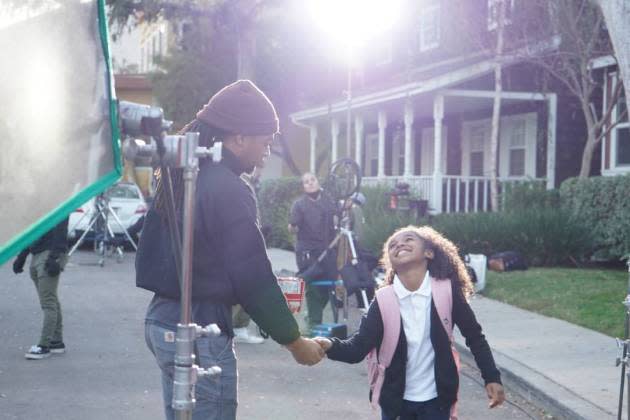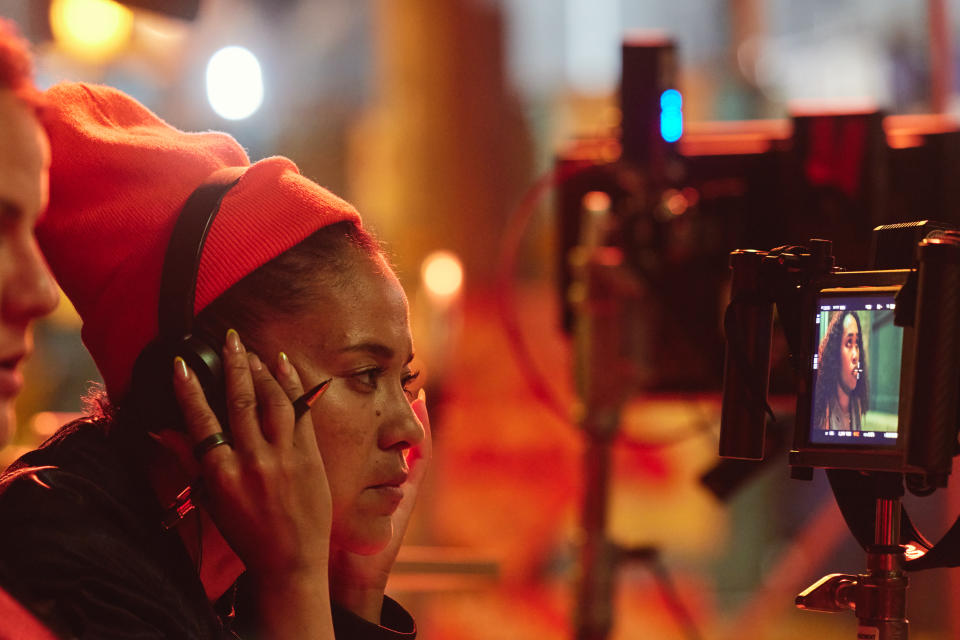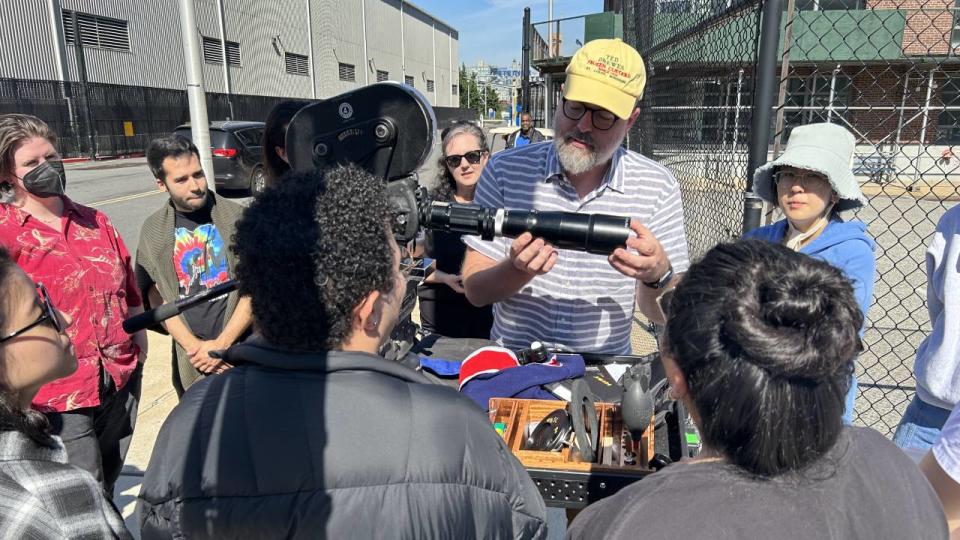From Mentorships With Comedy Veterans to Golden Globe-Funded Scholarships, These Film Schools Are Championing Underrepresented Filmmakers
- Oops!Something went wrong.Please try again later.

When California State University Northridge’s head of film production Nate Thomas came to visit one of his first students, Paul Hunter, on the set of the new David Oyelowo-starring Apple TV Plus series “Government Cheese,” the Northridge alum and show co-creator could be heard boasting about his time in the program.
After learning to tell stories at CSUN, Hunter spun a renowned career directing music videos for Beyonce and U2, among others, into helming Bacardi spots with Michael B. Jordan and Cannes Golden Lion-winning campaigns for Nike. Much of that has been through PrettyBird, a Hollywood commercial house he co-founded and uses in part to help foster and launch the careers of other underrepresented voices. “It all started at Northridge,” Thomas says. “We do filmmaking not just for the privileged. We make it for all people who have a story to tell.”
More from Variety
Since 2016, the Hispanic-serving institution’s film and television arts department has supported that prospect by providing five full-ride scholarships for four underrepresented undergraduates and one MFA student each year through a $2 million gift from long-time donor, The Golden Globes Foundation. Support also comes from alums like “The Conners” executive producer Dave Caplan, who conceived of the school’s new comedy writing mentorship. Launched this semester, Caplan and five comedy showrunners were paired with six Northridge students from diverse backgrounds to prepare them for a career in screenwriting.
“We have a very large student population in our film department and we pride ourselves on looking for those individual voices and promoting them,” says Jared Rappaport, chair of the Department of Cinema and Television Arts.
Students’ film studies can also benefit from coursework within other schools, including Northridge’s expansive Humanities department, whose American Indian program recently co-sponsored an evening with “Reservation Dogs” writer-director Tazbah Chavez. With degrees around disability, queer, Middle Eastern, and more cultures, students can diversify or laser focus their storytelling skills and expertise.
“We’ve had students that take our Chicano and Film curriculum in Chicano studies,” says the film production head. “We’ve had a Holocaust love story period piece where they spoke Yiddish, and [the students] took classes with the Jewish Studies department.”

Thirty minutes away in L.A., two postgraduate programs from the AFI Conservatory — the Directing Workshop for Women and its Cinematography Intensive for Women — have supported underrepresented gender identities for years. At the four-day workshop for DPs, fellows are pivoting into the below-the-line role, working on a set where they’re “dealing with everything from what it means to be a woman in that department to what it means to be a great cinematographer,” says AFI Conservatory Dean and Executive Vice President Susan Ruskin.
For DWW+, which is celebrating its semicentennial this year and boasts alums like Oscar-winner Siân Heder and Pulitzer-nominee Maya Angelou, the two-year, tuition-free intensive is open to those already familiar with the business and interested in making a short film. Once funded — a process that’s guided, and in certain circumstances of need partially funded by AFI — directors build among an array of skills ways to “find common ground and learn about story[telling] from other points of view,” while mentors offer analysis to help fine-tune the film.
“It’s not about learning to be a director. You should already know what it means,” Ruskin says. “It’s to open doors, and to be a part of the community. Those are the two things that matter the most.”

At Brooklyn College’s Feirstein Graduate School of Cinema, that kind of approach is not limited to a program. Built specifically to create a diverse pipeline of talent for the New York film industry, the only public graduate school in the country integrated into a working film lot (Steiner Studios) is home to a student population that’s two-thirds people of color. Ethan Hawke, Franklin Leonard, and Steven Soderbergh sit on the advisory board for a school with student groups dedicated to BIPOC, women and queer filmmakers.
Students have access to scholarships like the Robert De Niro Award and get $10,000 towards their thesis projects — a commitment that will continue after a recent anonymous $500,000 donation from an Oscar-winner. As one of the only schools with degrees in sonic arts and media scoring, Feirstein creates a pathway to diversify film composing alongside a general curriculum that supports screening films like Rebeca Huntt’s “Beba” and experiencing seminars with talent like Oscar-winning producer Bruce Cohen and Cannes-winning director Apichatpong Weerasethakul.
“These are major filmmakers in the world … and [our students are] seeing people that look like them, and stories about them, on screen,” says executive director Richard N. Gladstein. “We do have to change the way that we’re educating people, so you have to decolonize the curriculum. The canon has to change a little bit.”
At Scottsdale Community College’s School of Film + Theatre, where 42.6% of the entire student population is BIPOC, it’s more than a difference in canon for students. Being the only public community college located on sovereign Native land means “there’s a real partnership and reverence,” says department chair Bill True, for the community being able to tell its story and “have its voice heard.”
In support of that philosophy, students have access to education and cultural support through the American Indian Program, in conjunction with free tuition for Salt River Pima-Maricopa Indian Community members. A career camp launched two years ago also works through the production process to teach high schoolers and prospective students from SRP-MIC the basics of production in just a week.
Before students articulate to top four-year programs like USC, UCLA, Chapman, Columbia College Chicago and AFI, they’ll have the chance to participate in six to 10 shorts using the school’s equipment warehouse, which features an inventory worth $2.5 million. Those looking to start work right after the associate’s program can tap into the school’s partnership with Film Commissioner Matthew Earl Jones on the Arizona Film Office’s Film Ready Initiative, becoming one of the 2,000 across the state within the next five years trained as industry-ready production assistants.
“Filmmaking is a craft — an occupation — and we’re an occupational program. But within that, we still celebrate the uniqueness of perspective,” True says. “That’s why people are drawn to us. They find that this is a friendly yet challenging place.”
Best of Variety
Sign up for Variety’s Newsletter. For the latest news, follow us on Facebook, Twitter, and Instagram.

